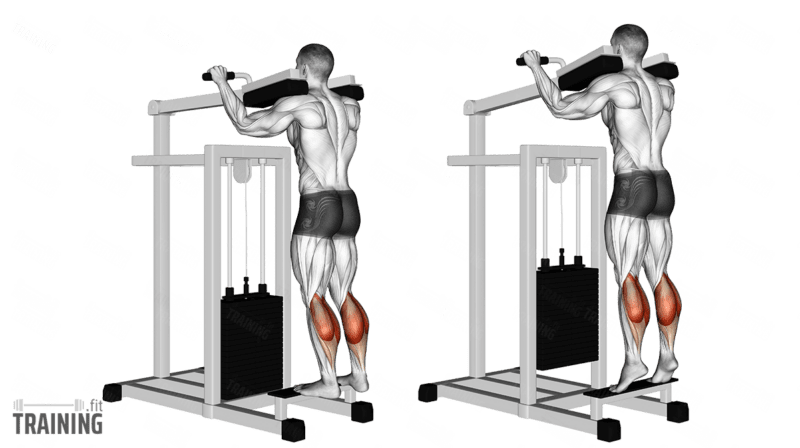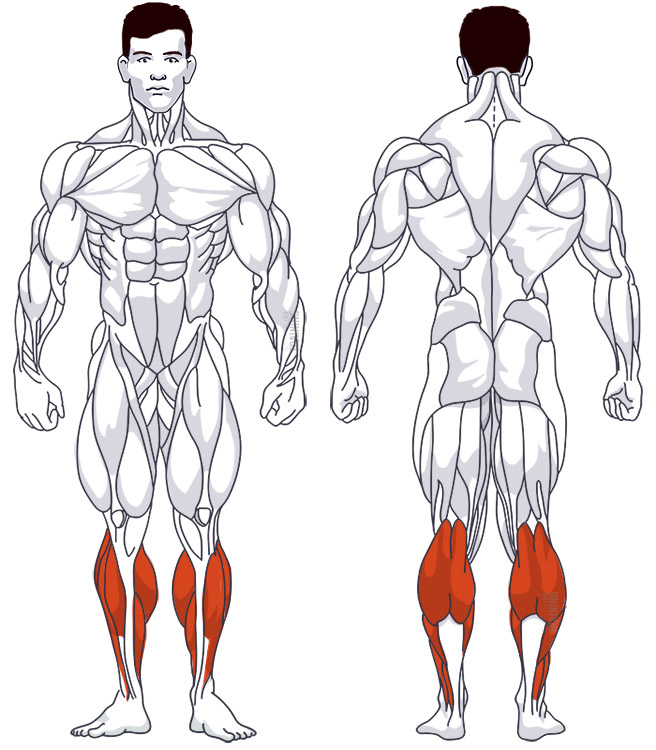Standing Calf Raise
Isolation exercise, MachineOverview

Main muscles
- Lower leg: Short fibula muscle
(Musculus peroneus brevis) - Lower leg: Long big toe flexor
(Musculus flexor hallucis longus) - Lower leg: Long fibular muscle
(Musculus fibularis longus) - Lower leg: Long toe extensor
(Musculus extensor digitorum longus) - Lower leg: Soleus muscle
(Musculus soleus) - Lower leg: Anterior tibial muscle
(Musculus tibialis anterior) - Lower leg: Twin calf muscle
(Musculus gastrocnemius)
Training plans
Standing Calf Raise is a suitable substitute for similar exercises in or as a supplement to various training plans.
Standing Calf Raise: Basics and alternatives

Involved main muscle groups:
Standing Calf Raise
While the seated machine calf raise is more common, the standing calf raise on the machine is also a fantastic isolation exercise for your calves. This exercise works by extending and flexing your ankles, just like other calf raise variations.
The key difference between standing and seated calf raises is the extended knee joints, which help target all the muscles in your lower leg more effectively, boosting your workout’s effectiveness.
If you prefer not to use a machine, you can also perform the standing calf raise with a barbell, a fitness band, or even without any equipment.
Correct execution
Various standing calf raise machines are available, and the shoulder pad and handgrip designs often differ. The most crucial aspect for proper execution is adjusting the pad height so the weight rests entirely on your shoulders.
Footrest designs can also vary. Ensure you have a secure footing on the balls of your feet, as the footrests might be rounded or sloping. Sometimes, footrests may adjust in angle with the weight’s movement. Always maintain a secure stance without the risk of slipping.
Video tutorial
Step-by-step instructions
Stand firmly on the machine’s footrest(s) with both feet. Slightly bend your knees to position your shoulders under the designated pads.
Keep your back straight and create a slight hollow in your lower back.
Straighten your knees, lifting the weight up to the shoulder pads. Keep your back straight throughout the exercise.
Flex your ankles, lowering the weight to reach the starting position.
Extend your ankles to lift the weight. Hold the extended position briefly before slowly and steadily lowering the weight by flexing your ankles, without using any momentum.
Common mistakes and injuries
The standing calf raise has more potential for mistakes than the seated variation.
Improper back posture is the most critical error. Keep your back straight with a slight hollow in your lower back throughout the exercise. A rounded back puts significant stress on your intervertebral discs.
As previously mentioned, secure footing on the footrests is vital. Because machines may have sloping, angled, or coated footrests, ensure careful and secure foot placement. Test the machine with light weight to find your most secure stance.
Avoid bending your knees during the exercise, as this will engage your thighs and reduce the focus on your calves.
Refrain from swinging the weight up and down. Such motion can cause short-term and long-term damage to tendons, muscles, and joints. Always perform the exercise slowly and steadily, without jerking the weight or using momentum from your feet and ankles. Lower the weight if it prevents clean execution.